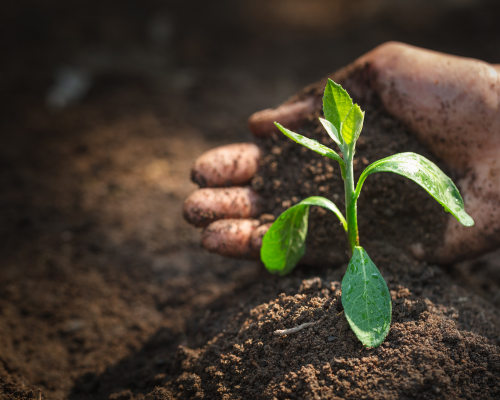The efficient management of agricultural resources, especially water, depends largely on our ability to understand and monitor soil conditions . In this context, agricultural soil sensors have become indispensable tools for farmers. These advanced technologies provide crucial data that allow for irrigation optimization, improved soil health, and increased crop productivity. Thanks to the sensors, it is possible to precisely control variables such as moisture, pH, salinity, and temperature, facilitating more informed and efficient decision-making in agricultural management.
Types of soil sensors: A range of possibilities
The agricultural soil sensor market for soil monitoring offers a wide variety of devices, each with its own unique features and applications. Below, we explore the most common sensor categories that provide accurate data on soil conditions:
Soil moisture: The heart of efficient irrigation
Soil moisture is one of the most critical parameters in agriculture, as it has a direct impact on plant growth and development. Proper moisture management is essential to ensure that crops receive the right amount of water at every stage of their development. Soil moisture sensors provide real-time information on the water content in the root zone, which in turn allows irrigation to be adjusted to the specific needs of each crop. By using these sensors, farmers can avoid both overwatering and underwatering, optimizing resource consumption and improving overall plant health.
Blood pressure monitors
Tensiometers measure soil water potential, that is, the strength with which water is retained by soil particles. These devices operate using a porous capsule that interacts with soil water, and the resulting tension is measured using a vacuum gauge. Tensiometers can be analog or digital.
- Advantages: Tensiometers are fast, practical, economical and are not affected by soil salinity.
- Disadvantages: They require periodic maintenance and do not perform optimally in very dry or sandy soils.
Volumetric Humidity Probes
These probes measure the volumetric water content in the soil and are divided into two main types:
- TDR (Time Domain Reflectometry) probes : These use electromagnetic pulses to measure soil moisture, providing accurate measurements, although they can be affected by salinity.
- FDR (Frequency Domain Reflectometry) probes: These measure soil capacitance and, although less accurate than TDR probes, are cheaper and easier to install.
Volumetric moisture probes are especially useful for measuring moisture at different depths and in various soil types.
- Advantages: They provide direct measurements of soil water content.
- Disadvantages: TDR probes can be sensitive to salinity and FDR probes have lower levels of accuracy, especially in clayey soils or soils with high organic matter.
Neutron Probes
These probes use neutron scattering to measure water content in the soil. They are extremely accurate and are primarily used in scientific research due to the radiation they emit. Operating these types of sensors requires compliance with special regulations.
- Advantages: Highly accurate for measuring moisture at great depths.
- Disadvantages: They require special permits due to regulations on the use of radiation.
Other parameters to take into account
In modern agriculture, soil moisture is not the only important parameter to monitor, but other key factors also influence crop health and resource efficiency.
Fortunately, today’s technology offers advanced solutions that allow us to accurately monitor and manage these parameters. Soil sensors, capable of measuring aspects such as salinity, pH, temperature, and soil composition, are essential tools for precision agriculture, helping to optimize irrigation, fertilization, and soil health. Thanks to these technological innovations, farmers can make more informed decisions tailored to the specific needs of their crops, improving productivity and long-term sustainability.
Electrical Conductivity (EC) Sensors
Electrical conductivity (EC) sensors measure the soil’s ability to conduct an electric current, allowing the concentration of dissolved salts in the soil to be inferred. This type of sensor is essential for monitoring salinity, a factor that particularly affects crops in arid regions or greenhouses.
- Advantages: They are essential for monitoring salinity and preventing problems such as salt stress in crops.
- Disadvantages: They are not suitable for measuring other soil parameters, such as moisture or pH.
pH sensors
Soil pH is a key indicator of the acidity or alkalinity of the environment, which influences the availability of nutrients to plants. pH sensors allow precise pH measurements at different locations in the field or greenhouse, helping to determine if the soil is suitable for a specific crop.
- Advantages: They facilitate the correction of imbalances in soil pH, improving nutrient absorption.
- Disadvantages: They require frequent calibration to ensure accurate measurements.
Soil temperature sensors
Soil temperature is another key factor influencing seed germination, root growth, and soil microbial activity. Soil temperature sensors measure temperature variations at different depths, helping to optimize planting timing and conditions.
- Advantages: They improve crop management, since soil temperature can affect growth rate and nutrient efficiency.
- Disadvantages: Its use is limited to situations where soil temperature is a critical factor for the crop.
Optical Sensors
Optical sensors use light reflection from the soil to measure properties such as organic matter and soil texture. This advanced technology is primarily used in precision agriculture, allowing real-time monitoring of soil conditions.
- Advantage: They provide detailed information on the physical properties of the soil.
- Disadvantage: Their cost is high and they require specialized equipment for their operation.
- Advantage: They provide accurate and detailed information on the chemical and physical composition of the soil.
- Disadvantage: They do not allow real-time measurements and require additional equipment to process the samples.
How to choose the right soil sensor for your needs
The choice of the right agricultural soil sensor will depend on several factors, including crop type, soil conditions, and the grower’s specific goals. For example, tensiometers are ideal for crops such as tomatoes, strawberries, and vineyards, where precise monitoring of water stress is essential. Volumetric moisture sensors, on the other hand, are more suitable for large-area crops such as cereals or in precision agriculture, where optimizing water use is key. Electrical conductivity sensors are primarily used in arid areas or for crops with salinity issues, such as rice or dates.
It’s also important to consider soil type (clay, sand, etc.) and crop root depth, as these factors will influence the accuracy and usefulness of the selected sensors. The availability of monitoring systems and data management software will also play a crucial role in the effective implementation of these technologies.
At OdinS we have more than a decade of experience in implementing IoT Smart Agro solutions.
Thinking about starting a smart agriculture project or improving an existing installation? Our team of IoT and agriculture experts will help you find the best solution to achieve your goals. We’re here to help you make the best decision!
Do you need help?
Fill out the form and we will
we will be able to contact you.
Our customer service hours are Monday to Thursday from 08:00 to 17:00, Friday from 08:00 to 15:00. We will try to respond to you as soon as possible.




